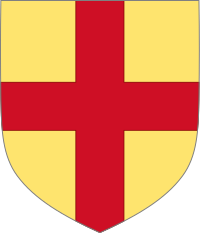
Summary
Walter de Burgh, 1st Earl of Ulster, 2nd Lord of Connaught (English: /dˈbɜːr/; d’-BER; c. 1210 – 28 July 1271) also spelt Burke or Bourke, was an Irish peer from the House of Burgh.
Walter de Burgh | |
|---|---|
| 1st Earl of Ulster | |
 | |
| Tenure | 1264–1271 |
| Predecessor | Richard Mór de Burgh, 1st Lord of Connaught |
| Successor | Richard Óg de Burgh, 2nd Earl of Ulster |
| Native name | Walter de Búrca |
| Other titles | 2nd Lord of Connaught |
| Born | c. 1210 |
| Died | 28 July 1271 Galway |
| Spouse(s) | Lady Maud de Lacy (1264) Aveline FitzJohn Fitzgeoffrey |
| Issue | Richard Óg de Burgh Theobald de Burgh William de Burgh Thomas de Burgh Egidia de Burgh |
| Parents | Richard Mór de Burgh, 1st Lord of Connaught Egidia de Lacy |
Biography edit
De Burgh was the second son of Richard Mór de Burgh, 1st Lord of Connaught and Egidia de Lacy.
In 1243, he succeeded his father as Lord of Connacht. In a royal order from Westminster in September 1247, Sir John Fitzgeoffrey was charged by the king with seizing the lands of Walter de Burgh's older brother Richard, who had died. The de Burgh lands in Connaught were being held by John de Livet, likely the son of Gilbert de Lyvet, one of the earliest Lord Mayors of Dublin and Marmaduke de Eschales (Scales).
The traditional account that Walter de Burgh became earl of Ulster through marriage to a cousin is no longer generally accepted.[2][3] According to that account, Walter married a cousin, Lady Maud de Lacy, only daughter and heiress of Hugh de Lacy, 1st Earl of Ulster (by his second wife, Emmeline de Riddlesford, the granddaughter of Walter de Riddlesford). It was asserted that in 1264 De Burgh was created Earl of Ulster in her right.[4][5][citation needed] Walter de Burgh was granted the lands of Ulster in 1263 by Edward, who had been granted Ireland in 1254.[6][2]
In 1270, he and Walter de Ufford, the Justiciar of Ireland, were defeated by Aedh mac Felim Ua Conchobair at Áth an Chip.
He married Avelina, daughter of Sir John Fitzgeoffrey, Justiciar of Ireland, about 1257.[2]
He died, aged about 60, in Galway, and was succeeded by his eldest son, Richard Óg de Burgh, 2nd Earl of Ulster ('The Red Earl of Ulster'). Other children were three sons, Theobald, William and Thomas, and a daughter, Egidia, who married Sir James Stewart (1260–1309), 5th High Steward of Scotland.[7][8]
Ancestry edit
| Ancestors of Walter de Burgh, 1st Earl of Ulster | ||||||||||||||||||||||||||||||||||||||||||||||||||||||||||||||||||||||||||||||||||||||||||||||||||||||||||||||||||||||||||||||||||||||||||||||||||||||||||||||||||||||||||||||||||||||||||||||||||||||||||||||||||||||||||||||||||||||||||||||||||||||||||||||||||||||||||||||||||||||||||||||||||||||||||||||||||||||||||||||||||||||||||||||||||||||||||||||||||||||||||||||||||||||||||||||||||||||||||||||||||||||||||||||||||||||||||||||||||||||||||||||||||||||||||||||||||||||||||||||||||||||||||||||||||||||||||||||||||||||||||||||||||||||||||||||||||||||||||||||||||||||||||||||||
|---|---|---|---|---|---|---|---|---|---|---|---|---|---|---|---|---|---|---|---|---|---|---|---|---|---|---|---|---|---|---|---|---|---|---|---|---|---|---|---|---|---|---|---|---|---|---|---|---|---|---|---|---|---|---|---|---|---|---|---|---|---|---|---|---|---|---|---|---|---|---|---|---|---|---|---|---|---|---|---|---|---|---|---|---|---|---|---|---|---|---|---|---|---|---|---|---|---|---|---|---|---|---|---|---|---|---|---|---|---|---|---|---|---|---|---|---|---|---|---|---|---|---|---|---|---|---|---|---|---|---|---|---|---|---|---|---|---|---|---|---|---|---|---|---|---|---|---|---|---|---|---|---|---|---|---|---|---|---|---|---|---|---|---|---|---|---|---|---|---|---|---|---|---|---|---|---|---|---|---|---|---|---|---|---|---|---|---|---|---|---|---|---|---|---|---|---|---|---|---|---|---|---|---|---|---|---|---|---|---|---|---|---|---|---|---|---|---|---|---|---|---|---|---|---|---|---|---|---|---|---|---|---|---|---|---|---|---|---|---|---|---|---|---|---|---|---|---|---|---|---|---|---|---|---|---|---|---|---|---|---|---|---|---|---|---|---|---|---|---|---|---|---|---|---|---|---|---|---|---|---|---|---|---|---|---|---|---|---|---|---|---|---|---|---|---|---|---|---|---|---|---|---|---|---|---|---|---|---|---|---|---|---|---|---|---|---|---|---|---|---|---|---|---|---|---|---|---|---|---|---|---|---|---|---|---|---|---|---|---|---|---|---|---|---|---|---|---|---|---|---|---|---|---|---|---|---|---|---|---|---|---|---|---|---|---|---|---|---|---|---|---|---|---|---|---|---|---|---|---|---|---|---|---|---|---|---|---|---|---|---|---|---|---|---|---|---|---|---|---|---|---|---|---|---|---|---|---|---|---|---|---|---|---|---|---|---|---|---|---|---|---|---|---|---|---|---|---|---|---|---|---|---|---|---|---|---|---|---|---|---|---|---|---|---|---|---|---|---|---|---|---|---|---|---|---|---|---|---|---|---|---|---|---|---|---|---|---|---|---|---|---|---|---|---|---|---|---|---|---|---|---|---|---|---|---|---|---|---|---|---|---|---|---|---|---|---|---|---|---|---|---|---|---|---|---|---|---|---|---|---|---|---|---|---|---|---|---|---|---|---|---|---|---|---|---|---|---|---|---|---|---|---|---|---|---|---|---|---|---|---|---|---|---|---|---|---|---|---|---|---|---|---|---|---|---|---|---|---|---|---|---|---|---|---|---|---|---|---|---|---|---|---|---|---|---|---|
| ||||||||||||||||||||||||||||||||||||||||||||||||||||||||||||||||||||||||||||||||||||||||||||||||||||||||||||||||||||||||||||||||||||||||||||||||||||||||||||||||||||||||||||||||||||||||||||||||||||||||||||||||||||||||||||||||||||||||||||||||||||||||||||||||||||||||||||||||||||||||||||||||||||||||||||||||||||||||||||||||||||||||||||||||||||||||||||||||||||||||||||||||||||||||||||||||||||||||||||||||||||||||||||||||||||||||||||||||||||||||||||||||||||||||||||||||||||||||||||||||||||||||||||||||||||||||||||||||||||||||||||||||||||||||||||||||||||||||||||||||||||||||||||||||
Notes edit
- ^ Burke, Bernard (1884). The general armory of England, Scotland, Ireland, and Wales; comprising a registry of armorial bearings from the earliest to the present time. University of California Libraries. London : Harrison & sons.
- ^ a b c Frame, Robin. "Burgh, Walter de, first earl of Ulster (d. 1271)". Oxford Dictionary of National Biography. Retrieved 7 September 2023.
- ^ Dictionary of National Biography. Vol. 7. New York Macmillan. 1886. pp. 328–329.
- ^ O'Donovan, John (1856). Annals of the Kingdom of Ireland. Hodges, Smith and Company. p. 393. Retrieved 28 December 2017.
- ^ Banks, Thomas Christopher (1843). Baronia Anglica concentrata; or, a Concentrated Account of all the Baronies commonly called Baronies in Fee. Author. p. 206. Retrieved 28 December 2017.
- ^ Mackay, Ronan. "Burgh, Walter de". Dictionary of Irish Biography (2009). Retrieved 15 September 2023.
- ^ Archer 1886.
- ^ Frame, Robin (2004). "Burgh, Walter de, first earl of Ulster (d. 1271), magnate and soldier". Oxford Dictionary of National Biography (online ed.). Oxford University Press. doi:10.1093/ref:odnb/3998. ISBN 978-0-19-861412-8. Retrieved 21 December 2021. (Subscription or UK public library membership required.)
References edit
Citations edit
Bibliography edit
- Archer, Thomas Andrew (1886). . In Stephen, Leslie (ed.). Dictionary of National Biography. Vol. 7. London: Smith, Elder & Co.
- Harbison, Sheelagh (1995), "Rindown Castle: a royal fortress in Co. Roscommon", Journal of the Galway Archaeological and Historical Society, 47
- Hayden, Alan (1988), "Excavation on the line of the medieval town defences of Loughrea, Co. Galway", Journal of the Galway Archaeological and Historical Society, 41 JSTOR 25535575
- Holland, Patrick (1993), "Anglo-Norman Galway; rectangular earthworks and moated sites", Journal of the Galway Archaeological and Historical Society, 46
- Holland, Patrick (1988), "The Anglo-Normans in Co. Galway: the process of colonization", Journal of the Galway Archaeological and Historical Society, 41 JSTOR 25535573
- Holland, Patrick (1997), "The Anglo-Norman landscape in County Galway; land-holdings, castles and settlements", Journal of the Galway Archaeological and Historical Society, 49
- Knox, Hubert T. (1908). The History of the County of Mayo to the close of the sixteenth century. Dublin: Hodges, Figgis and Company.
- MacLysaght, Edward (1978), The Surnames of Ireland, Dublin
{{citation}}: CS1 maint: location missing publisher (link) - Moody, T. W.; Martin, F. X.; Byrne, F. J., eds. (1989). A New History of Ireland: IX: Maps, Genealogies, Lists, A Companion to Irish History, Part II. Oxford: Oxford University Press. ISBN 978-0-19-959306-4.
- Earls of Ulster and Lords of Connacht, 1205–1460 (de Burgh, de Lacy and Mortimer), p. 170.
- O'Donovan, John (1843), The Tribes and Customs of Hy-Many, commonly called O'Kelly's Country, Dublin: Irish Archaeological Society
- Weiss, Frederick, Ancestral Roots of Certain American Colonists Who Came to America Before 1700, pp. Lines 73-30, 177B-8, 177B-9
External links edit
- Annals of Ulster at CELT: Corpus of Electronic Texts at University College Cork
- Annals of Tigernach at CELT: Corpus of Electronic Texts at University College Cork
- Revised edition of McCarthy's synchronisms at Trinity College Dublin.


